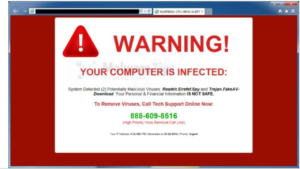
In an age where almost everyone has access to the Internet, not a day goes by that we don’t surf the web. It can be watching videos on YouTube, scrolling through our Facebook feeds, or even mindlessly surfing and going down one rabbit hole after another. Yes, we might run into a few annoying pop ups every now and then. Most of the time they’re harmless. But there is one in particular that really needs to be taken seriously.
It happens when you’re just browsing around and all of a sudden you’re redirected to a page. It has something that says “your computer is infected”. Sometimes, it will have a robotic voice saying “Warning…your computer is undetected” or the like. And then there’s a pop-up prompt repeating the same message, telling you to call an 1-800 number. You may know better, but there’s a lot that don’t. Especially those who are not familiar with computers such as older people.
So after repeatedly closing out the prompt after it pops up repeatedly, you finally close the browser tab. Persistent, aren’t they? So you’re probably wondering, how did these come about? And why are they a scam? We’ll answer these questions and delve into a lot more about how these so-called “tech support” scammers operate.

The History Of This Type Of Scam:
The “tech support” scam is one of a handful of telephone scams. As any traditional telephone scam operates, the scammer would typically cold call you. This type of telephone scam can be dated back as far as 2008. Often, the targets were residents that were living in English-speaking countries like the United States, Canada, the United Kingdom, Ireland, Australia, and New Zealand. These scams were typically made from call centers originating in India.
How This Type Of Scam Works:
As mentioned before, usually you will be surfing the web as normal. There will be a time when you’ll be doing something like clicking to scroll down a page and a separate window pops up. This will load up a page that comes with some type of warning. This may be followed by a pop-up prompt with a message that is usually repeated by a robotic voice. Then it will have an 1-800 number that people “need to call” for tech support.
If you dial the number, you will be linked to someone who poses as a “tech support” representative. Once you connect with the scammer, you will explain to them the nature of your call. At this point, what the scammer will do is use confidence tricks in an effort to gain enough trust from you to access your computer remotely. They will typically ask you to download a program like GoToAssist, TeamViewer, or other software that allows you to access your computer remotely.
Then, as the call progresses, the scammer will often use some other tricks like making a misdiagnosis of your computer, false claims regarding warranty, and other methods. They will often use methods like keylogging, ensuring that you are locked out of your computer the next time you’ve logged in. There will be times when they will send you a program that claims to “fix” the problem. However, it is a program that has a virus or malware attached to it.
Finally, the scammer will ask for the caller’s credit card information. They do this in an effort to add more fraudulent charges. At the same time, the scammer will ask for bank information from the caller by promising them a refund for their services. Yet, the real purpose is for the scammer to extract more money from their victims. Some scammers may also request payments in the form of gift cards from brands like Amazon, Google Play, or the iTunes store.
Another alternative method for this scam is when the scammer “cold calls” and claims to be tech support from Microsoft, Apple, Google, etc.
Who Is Affected And How You Should Protect Yourself:
Typically, the scammers will prey on senior citizens, the vulnerable (like children), and even those that are not familiar with the use of a computer. These are the type of scams that use scare tactics to trick people into “using their services”. For example, a scammer can claim that they may have downloaded illegal files on their computer and may be arrested by law enforcement if they are not taken care of. They will make it like they are the only ones that can be helpful in such a situation.
One thing you need to know about your computer, is that the manufacturer never includes a phone number in any of its error messages. If you see such a prompt, there’s a good chance that it is not legitimate. If a typical computer user has a problem, it’s common sense that they would either contact the real Microsoft or Apple tech support or someone in their local area familiar with computer issues.

Things You Should Keep In Mind:
- Microsoft and Apple will never request payment for its services and products in the form of money, gift cards, or cryptocurrency (like Bitcoin).
- Only download programs from Microsoft or Apple or their trusted partners.
- Any communication to Microsoft or Apple, will be initiated by you, not them. They don’t initiate you with “pop up’s” either!
- If a notification appears with a phone number, do not call it, period.
- Turn on any security settings or firewalls that can prevent unwanted traffic, that may carry viruses and malware.
- Use a web browser that has good security features.

What If I Have Given My Information To A Scammer:
In the event that a scammer may have your information, then you’ll need to uninstall the programs that you were sent immediately. Next, you’ll need to do a full scan using Windows Security to ensure that it picks up all the malware it detects. Once the scan is complete, get rid of the malware. As a rule, apply all security updates as soon as they are available. Don’t forget to change your passwords as they may have been compromised. Then turn on Windows Defender Firewall to block traffic to programs that you don’t always access. Lastly, be sure to contest the charges of the purchases on your credit card or bank account.
As an alternative method, you can do a factory reset of your device. This may be the most time consuming, but it will give you a fresh install of your operating system free from viruses and malware.

My Final Conclusion:
These tech support scams remain a problem, even today. Chances are after you read this, you might run into one. In the future, it would be wise for you to steer clear of technical error prompts that include a phone number. At the same time, you should consider installing a reliable antivirus system like “Norton”. So when your computer is really in trouble, they’ll be the ones to alert you via their software, and not some strange website.
Do you have any experience with being scammed by the so called, “tech support team”? Do you have any questions about this particular tech support scam? If so, please leave your comments or questions below, and I will be more than happy to get back to you.
Looking for real, legit work online instead?
Click here To Read My # 1 Recommendation!
If you enjoyed reading and educating yourself on technical computer support scams, please don’t limit yourself. Feel free to learn “all about” a different, online money making scheme/scam like:
Success With Anthony Scam Review
Stuffing Envolopes Scam Review
And Much More..


